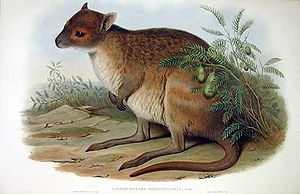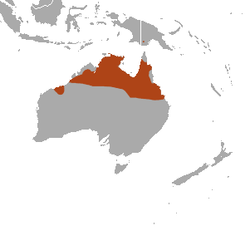Spectacle rabbit kangaroo
| Spectacle rabbit kangaroo | ||||||||||||
|---|---|---|---|---|---|---|---|---|---|---|---|---|

Spectacled Rabbit Kangaroo ( Lagorchestes conspicillatus ), |
||||||||||||
| Systematics | ||||||||||||
|
||||||||||||
| Scientific name | ||||||||||||
| Lagorchestes conspicillatus | ||||||||||||
| Gould , 1842 |
The rabbit kangaroo ( Lagorchestes conspicillatus ) is a species of marsupial from the kangaroo family (Macropodidae). It is the most common and the most widespread representative of all rabbit kangaroos .
features
Spectacle rabbit kangaroos reach a head body length of 40 to 47 centimeters, plus a 37 to 49 centimeter long tail. Their weight is 1.6 to 4.5 kilograms. Their long, dense fur is gray-brown to yellow-gray on the upper side, the underside is lighter, usually reddish-white. The name-giving feature is the reddish spots around the eyes, on the hip there may be whitish fur markings. As with most kangaroos, the hind legs are significantly longer and stronger than the front legs, and the tail is long and muscular.
distribution and habitat
In the past, spectacled rabbit kangaroos lived in almost the entire northern half of Australia , today their range is reduced, although not to the same extent as the other rabbit kangaroos. You can still find them in northeastern Western Australia including the offshore Barrow Island , in the northern Northern Territory and in northern Queensland . There are also unconfirmed reports of its occurrence in New Guinea . The population on Barrow Island forms the subspecies Lagorches conspicillatus conspicillatus , the remaining animals the subspecies L. c. leichardti .
The animals inhabit a number of habitats, including open wooded areas and scrubland, but also dry grasslands overgrown with spiked grass.
Way of life
These kangaroos are crepuscular and nocturnal, during the day they hide in thickets or other shelters. On Barrow Island, the animals have an area of 8 to 10 hectares in which they have several shelters. At night they go looking for food, eating leaves and grasses. Like all kangaroos, they have a multi-chambered stomach for better utilization of the difficult to digest plant food. You don't need to drink. Usually they live solitary, but sometimes up to three animals go looking for food together.
Mating can take place all year round. The young animals spend their first five months in their mother's pouch and are independent at around one year.
Danger
The reasons for the decline in the spectacle rabbit kangaroos are diverse and not always known. The reasons are likely to have been the reenactment by introduced predators such as foxes and cats , the transformation of their habitat and the food competition from introduced herbivores and grazing animals.
Today the situation is different: in some regions such as northern Western Australia they are very rare, in Queensland mostly still relatively common. Overall, the IUCN lists the species as not endangered due to its large distribution area.
The only holder of European zoo history was Frankfurt.
supporting documents
literature
- Ronald M. Nowak: Walker's Mammals of the World. 6th edition. Johns Hopkins University Press, Baltimore 1999, ISBN 0-8018-5789-9 .
Web links
- Lagorchestes conspicillatus onthe IUCN Red List of Threatened Species . Retrieved May 16, 2009.
